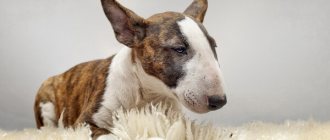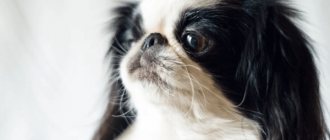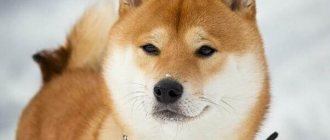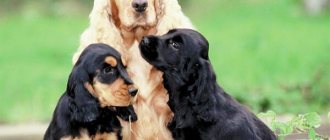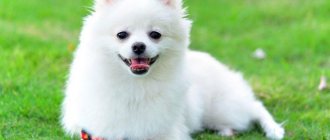Pomeranians are decorative dogs that have recently become increasingly popular due to their attractive exterior.
But it is very important that the pet is liked not only in appearance, but also in temperament, activity level and character traits.
Therefore, before purchasing a pet, you should find out more about it, read reviews from other owners - this will help you make the right decision.
Breed characteristics
The classic German Spitz breed is divided into several types depending on height. The smallest representative of this group is the dwarf or Pomeranian Spitz (Zwergspitz). There are also differences within the subspecies. Dwarf Pomeranians are divided into three types:
- “bear” with a round muzzle, full cheeks and a slightly raised chin;
- “fox” with an elongated muzzle, a button nose, a narrow chin and fluffy cheeks;
- “toy” (“baby doll”) with wide-set eyes and a muzzle similar to a bear’s, but flatter.
The differences concern only the appearance, but not the character of the animal. These descendants of an ancient canine family need to be trained in the same way: regularly, persistently and patiently. Small height, maximum 22 cm, and weight up to 3.5 kg allows you to keep your baby even in a small apartment. You can walk with your Pomeranian Spitz in any weather: a chic, warm coat reliably protects you from cold and wind. A doll dog will live 12-16 years, and with proper care, even more is possible.
What are the benefits of Pomeranians?
The advantages of the Pomeranian Spitz breed are not limited to the pet’s doll-like appearance. Description of the positive qualities of furry babies:
- Character. There are simply no such things as harsh or boring Pomeranians. This is a “smiling dog” with an affectionate and playful disposition.
- "Live bell" Excellent hearing allows the dog to act as an alarm system. The pet will instantly and loudly inform the owner of any danger.
- Cleanliness. The Pomeranian grooms itself carefully, almost like a cat. He washes himself and licks out any dirt on the fur.
- Endurance. Good health and the ability to easily endure cold and prolonged stress are the heritage of harsh, hardy ancestors.
- Amenability. The dog is able to “fit in” with any team; he peacefully coexists not only with people, but also with other animals in the house.
Loyalty is an undoubted virtue. But there is also a downside: the dog really doesn’t like being alone. Those who choose a cheerful pet as a companion will have to devote a lot of time and attention to him.
Weaknesses of bitter orange
Owners of Pomeranian Spitz note several possible problems that can hardly be called defects of the breed. These are, rather, inconveniences caused by the characteristics of a fluffy dog:
- Wool "all over the area." If you comb your dog on time and thoroughly, there will be no special problems with cleaning. The dog actively sheds only during the season (spring). During this period, the pet will have to be combed daily.
- Teeth. The period of changing teeth is difficult for both the owner and the dog. Baby teeth often have long roots and refuse to fall out and give way to permanent ones. As a result, an incorrect bite is formed. If this happens, you will have to contact a veterinarian.
- Barking. Pomeranians are very talkative. They bark with or without reason simply from the generosity of their souls. But with proper training, this deficiency is eliminated quite quickly.
- The desire to dominate. This character trait needs to be eradicated from day one. You cannot allow the puppy to feel like the “leader of the pack” even for a minute.
A well-bred and timely vaccinated dog usually does not cause problems, but the owners will have to go through a difficult stage of upbringing and “grinding in” their characters. As soon as the baby recognizes the person as the main one, he will become an affectionate, obedient and cheerful companion.
Behavior and character: the pros and cons of the orange
Fluffy and cute “bear cubs” love to stage “one-man shows.” They will appear sick, unhappy, offended and hungry, only for the owner to take pity, take him in his arms and allow him to do what the little cunning one wants. If it is not possible to get a person’s attention, there will be a refusal to play or eat, barking and whining, turning into a prolonged hysteria.
If there are already other animals in the house when the puppy arrives, the baby perceives them as part of the pack. But the arrival of new inhabitants can cause jealousy and even aggression towards newcomers. However, the child and the Pomeranian quickly find a common language: both of them adore fun activities and play together with pleasure.
The fluffy smart guy instantly remembers commands, but there may be problems with their execution. An independent and cunning child sometimes ignores his master’s orders, testing a person’s character to the limit. Such situations cannot be left to chance. It is necessary to achieve at least approximate execution of the command with patience and persistence (but not shouting!). The main thing is for the petty manipulator to understand “who’s boss.”
Good or evil? How does he treat children?
Pomeranians are not characterized by causeless aggression . Despite their unfriendly attitude towards strangers and other dogs, representatives of this breed will not attack unless there is a compelling reason to do so.
These dogs treat children well, but only those who grew up with them.
For the owner's child, the Pomeranian will become a faithful companion and playmate . In general, the dog will not show anger and aggression towards other people’s children, but will behave more reservedly and less friendly with them.
Care rules and possible problems
Compared to other decorative breeds, the Miniature Pomeranian does not require special care. Good pet health does not require constant supervision by a veterinarian; timely vaccinations and preventative visits to the clinic are sufficient.
- Combing. All dogs with long hair need to be combed. Pomeranians need this procedure daily during the molting season. The rest of the time, two brushings per week is enough.
- A haircut. Long hair makes it difficult for the animal to move and clean the house.
- Dental and ear hygiene. Teeth are the weak point of the breed. Regular visits to the veterinarian are necessary. You can clean your ears yourself with cotton pads or a napkin (no cotton swabs!)
- Bathing. It is recommended to bathe once every 1.5 months, but this is not a strict law. If your pet gets dirty, you should wash it immediately so that the fur does not become completely tangled.
The Pomeranian has a long-standing and devoted love affair with food. The dog eats everything and always. The owner’s task is to control the little glutton and all the household so that they do not overfeed the dog. Obesity is the first step to disease. You should not bathe your Pomeranian while shedding. Too frequent mechanical and chemical effects on the coat provoke the appearance of bald spots.
Origin story
The history of the origin of the breed has not been fully studied. It is generally accepted that its first representatives - peat dogs of the Neolithic period, appeared in the Stone Age in Switzerland. It was there, during excavations of pile buildings, that the remains of the so-called fossil Spitz were found. Archaeologists have discovered various objects depicting similar small dogs dating back to the civilizations of Ancient Rome and Greece. Evidence has been found that since the Middle Ages, Spitz dogs have been common in Europe, Asia and Africa.
In Russia, dogs were used as small reindeer-herding huskies. There is an opinion that large Spitz dogs are the result of crossing a husky and a Spitz. Large individuals were used for protection, and miniature ones became decorative favorites of the nobility. Such dogs were kept by: Catherine the Great, Josephine and Marie Antoinette.
Spitz dogs were especially popular in Germany, where in 1450 the name Spitzhund arose, which then finally took root. Since the 18th century, German breeders have been closely involved in developing breed standards. Over time, Spitz dogs have won worldwide love. They spread to Europe and Russia, and by the beginning of the 20th century they appeared in the USA. The Pomeranian fox was first registered by the AKC in 1888. In 1900 the association officially recognized the breed. Since then, the Spitz has firmly established itself in leading positions in the popularity ratings in many countries around the world.
Disadvantages of owning a Pomeranian
From the “technical” side, the biggest disadvantage of grooming is the long, thick coat. It needs to be combed and washed regularly. Other maintenance difficulties mainly arise in the absence of proper training. The desire to dominate is inherent to a greater extent in Pomeranian boys, but girls also know how to get their way through manipulation and hysterics.
The Pomeranian is a big fan of long walks. A couple of minutes outside just to go to the toilet is not about him. The owner will have to make time for long trips around the area. In addition, the dog’s inquisitive mind needs new experiences. If possible, the walking route should be changed from time to time.
Who would like a charming baby?
A cheerful, playful, funny Pomeranian is suitable for those who need “bright rainbows” among gray everyday life. This little miracle can change your mood in an instant and give selfless love and devotion. But you have to pay for everything: the dog cannot stand loneliness, loves long walks and fun activities. He also constantly strives to dominate, to become the “king of the hill.” A patient, persistent, and sometimes demanding owner is able to give the dog the right education and make its life happy.
Training
The mini bear-type Pomeranian is quite easy to train.
This does not require the owner’s physical strength or other manifestations of aggression. It is enough to give a clear command or confidently prohibit an action. You cannot make concessions, as Spitz feel the weaknesses of their owners. It must be remembered that the animal will strive for dominance. Spitz will happily carry out commands that contain elements of dance and a rollover. They respond less well to the “sit” command; most likely, this is due to the dog’s increased activity. Favorite command is “fetch”. The Spitz will happily run after an abandoned toy or bring the right thing. Already at seven months, a small dog is able to learn the following commands:
- "To me". The order is important especially in dangerous situations. When teaching this command, you should not approach the dog; you need to wait until it understands and comes on its own.
- "Near". Patience is required to effectively assimilate the order.
- "Ugh". When training a team, you need to observe some nuances. For example, do not pull the leash too hard, do not shout or use orders too often.
- "Give". This command is easy to teach using a ball.
The Spitz breed is suitable for breeding for both experienced dog breeders and beginners.
Smart dog with a difficult character
The Pomeranian is a worthy descendant of intelligent, independent sled and hunting dogs. The blood of the leader of the pack flows in his veins. And he will instantly demonstrate this if the owner gives him some slack. A funny dog should not be perceived as a toy or interior decoration. This is a full member of the family with its own needs and character. If you start training in time, the puppy will grow into an obedient and playful dog.
The charming little Pomeranian is a devoted companion, a cheerful playmate, a loud-voiced watchman and the best cure for stress. Yes, you will have to devote time and attention to your furry pet, but this is not too high a price to pay for a constant source of optimism and fun.
Caring for offspring
A bear-type Pomeranian puppy requires careful attention to its safety.
To do this, you need to follow the following rules: 1. Be sure to remove all wires from reach, as a small dog will chew anything that attracts its attention.
2. It is necessary to hide all the cracks, for example, behind a refrigerator or sofa. This is due to the fact that the puppy may get stuck while exploring the area.
3. A slippery floor should be covered with a special coating, because constant sliding can negatively affect the development of the dog’s paws.
4. Anything that has an odor must also be hidden so that the item does not attract the puppy’s attention. For example, fruit-scented dishwashing liquid, a bag of chalk, a garbage can, and so on.
5. It is necessary to protect the dog from drafts, since the Spitz does not tolerate them well.
6. You cannot leave the puppy on a hill; when jumping, it can damage its paws.
7. You need to pick up a small dog with both hands at the same time, since the muscles have not yet become stronger. You must hold it tightly so that it does not fall.
Of course, it is necessary to provide the puppy with proper sleep and, if possible, not leave him alone for a long time.
Questions and answers
What are the benefits of Pomeranians?
This is a fluffy bundle of genuine joy. A beautiful and charming pet with a “smiling” face, if properly raised, does not cause much trouble. “Technical” advantages of the breed: it takes care of its own coat, eats almost everything and rarely gets sick.
Weaknesses of bitter orange
From infancy, you need to monitor the condition of the Pomeranian's teeth, devote time to regular training and walks, limit the animal's appetite and visit a veterinarian.
A few words about feeding
The bear-type Pomeranian is not particularly picky about food. He should not be given fried, fatty, floury, or spicy foods. You should also exclude lamb, pork, sausage, frankfurters and long bones. The diet must include sea fish, various cereals, vegetables, dairy products, raw lean meat, and offal is given from seven months. You should not overfeed your dog, nor should you indulge in whims and change food for something more tasty. In the latter case, if you refuse to eat your usual food, the bowl is removed until the next feeding.
The transition to dry food should be gradual. When choosing “drying”, you must carefully read the composition. Poor quality food can significantly worsen a dog's health. Whether “drying” is suitable or not can be determined by the condition of the animal’s teeth, fur, and stool. This kind of food, of course, has its advantages. For example, this is ease of feeding, storage, and the absence of the need to include additives in the diet. An adult Spitz consumes from 50 to 80 grams of dry food per day.


